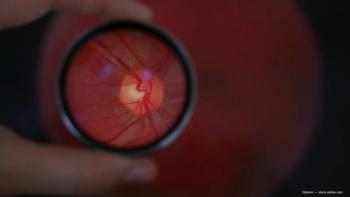
AAO 2024: Two-year clinical feasibility trial outcomes for a dual-optic IOL system for the treatment of presbyopia and cataract
Key Takeaways
- The OmniVu modular accommodative IOL system showed excellent safety and efficacy, maintaining refractive stability within a 1/2 diopter over 24 months.
- The dual-optic IOL system features a modular, exchangeable anterior optic and a fluid-filled, shape-changing base, allowing for adjustability and potential future applications.
George O. Waring, IV, MD, provides insights from an on-demand poster as part of the annual American Academy of Ophthalmology taking place in Chicago, Illinois. This poster was titled, "Two-Year Clinical Feasibility Trial Outcomes for a Dual-Optic IOL System for the Treatment of Presbyopia and Cataract."
George O. Waring, IV, MD, provides insights from an on-demand poster as part of the annual American Academy of Ophthalmology taking place in Chicago, Illinois. This poster was titled, "Two-Year Clinical Feasibility Trial Outcomes for a Dual-Optic IOL System for the Treatment of Presbyopia and Cataract."
This transcript has been lightly edited for clarity.
George O. Waring, IV, MD: Hi, it's George Waring IV, from the Waring Vision Institute in Mount, Pleasant, South Carolina, and it's my pleasure to discuss something really exciting here at the American Academy of Ophthalmology in Chicago. It's been a jam packed meeting, lot of extraordinary innovations in the pipeline, and one of the ones we're most excited about is modular accommodative IOLs. And we had the really wonderful opportunity to present on the OmniVu, modular lens system by Atia Vision. We presented the 24-month results, which is really exciting to start to get some long-term data on how this next generation of accommodating lenses are performing. And what we found was that we had an excellent safety and efficacy profile. These lenses are maintaining stability, refractive stability, over 24 months within a 1/2 diopter. And I think that's one of the really exciting things about this lens. This is a more physiologic lens. This is a two-piece system with a modular, exchangeable anterior optic and a fluid-filled, shape-changing base that provides accommodation. So this does a few things for us. It allows for adjustability over time, which is really exciting. It also creates a potential space for us for things like drug illusion or even virtual reality. Everything's on the table for the future. But I think most importantly, and most immediately, it's a more physiologic lens, as I mentioned, this maintains the natural capsule in a capsule filling way. Well, what does that mean? We believe that this can have some real benefits to promote effective lens position over time, and we really believe that this bore out in our 2-year data. When we look at the uncorrected binocular visual acuity outcomes, uncorrected distance acuity binocular was 20/16 intermediate 20/20, and near J1 and that's really exciting because, again, it promotes this idea of a full continuous range with, what we found to be, over four and a half diopters into focus at the 20/32, level, with really a natural range and also excellent quality of vision. So these are monofocal-like quality. It's a monofocal optic, but with the performance of an extended range, full vision range, actually, and that's amazing. So we marry the effective lens position opportunity with a continuous range with a high quality vision. Our results looking at, in a non-comparative way, the contrast sensitivity also behaves in a monofocal-like state. So ladies and gentlemen, we're really excited about this data, 2-year long-term data. We were very thankful to get to present it, and we're real optimistic about what the future holds with this technology.
Newsletter
Don’t miss out—get Ophthalmology Times updates on the latest clinical advancements and expert interviews, straight to your inbox.








































